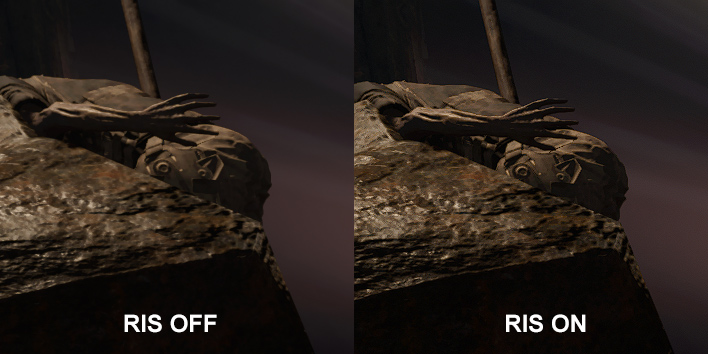AMD Radeon RX 5700 Image Sharpening Comparison Shows Impressive Visuals, Minimal Performance Hit
One of the features that we didn't get a chance to really do a deep dive into in our review, was Radeon Image Sharpening (RIS) and the performance impact that it may or may not have on games. In short, RIS is a contrast-adaptive algorithm that sharpens a game scene. RIS draws out details in low contrast areas of a scene, without negatively impacting high contrast areas. It is basically a post-processing compute shader that evaluates a 3x3 pixel neighborhood and applies the sharpening algorithm where applicable.
According to AMD, the sharpening algorithm improves image quality while only resolving in a 0.5 to 1.4 percent performance hit in popular game titles like Shadow of the Tomb Raider and Total War: Warhammer 2. AMD is promising to deliver crisper visuals for lower resolution gaming -- i.e. 1080p and 1440p -- for hardware that typically wouldn't be able to handle heavy 4K gaming loads or for those that simply want a boost in image quality. You can see a short backgrounder on RIS from AMD in the video above.
RIS is an exclusive feature that AMD has rolled out for Navi-based cards for now, so don’t expect to see it on cards like the Radeon VII or Radeon RX Vega 56/64 just yet. It is activated using a simple software toggle switch and it is not dependent on developers adding support.
Our initial view of the claimed image quality improvements was confirmed (as you can see above) but we decided to put RIS to the test and determine if AMD's claims of a sub-2 percent performance hit was also indeed accurate. We loaded up Strange Brigade and Shadow of the Tomb Raider, and put the Radeon RX 5700 to the test.

In Strange Brigade (1080p, Ultra Quality), with RIS disabled we got an average FPS of 141.2 and a minimum FPS of 98.3. With RIS on, the difference was negligible, amounting to less than one frame per second (both average and minimum FPS).

Moving over to Shadow of the Tomb Raider, it was more of the same at 1080p. The difference in performance with RIS disabled versus enabled basically came down to the margin of error variability in the benchmark.


The big question, however, is how does RIS look in action? To our eyes, we definitely noticed the sharpening of in-game objects and surfaces with added detail and without detectable artifacts. While it's not a complete replacement for running at higher resolutions, we can't argue with what is essentially a "free" fidelity boost in virtually any game engine with AMD's new Radeon RX 5700 series GPUs.





